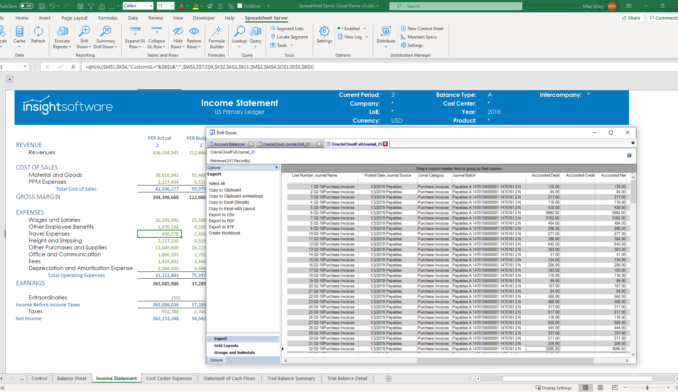The best decisions are made based upon accurate, timely information. For many businesses, that’s a goal that remains unmet. Instead of making decisions based on business data in real-time, they rely upon out-of-date, dubious information that leads to undesirable outcomes such as costly mistakes.
That situation doesn’t have to be the norm. Enterprise performance management solutions provide the most trustworthy and up-to-date business intelligence. Read on to learn how an enterprise performance management system allows you to make better decisions so you can stay agile, competitive, and take advantage of opportunities.
The Need for Business Analytics in Today’s Market
The speed of business is increasing. Gone are the days when you had operations in one geographic area or even a single time zone; you need to be aware of what’s going on in every department of your organization, no matter how widely dispersed they are. You can no longer survive on static spreadsheets, emails, or paper-based processes anymore.
Enterprise performance management solutions combine financial performance management and operational performance assessment and optimization. With such a solution, you can manage your entire organization from a single platform and analyze business intelligence in real time so you can become more efficient.
This raises the question of why business analytics are so crucial. Isn’t business intelligence enough? The problem is that business intelligence solutions only answer simple questions. Business analytics, on the other hand, simplify information in such a way that you derive valuable insights from it and can go on to make better decisions.
Better Decision Making: An Unattainable Goal?
Researchers at IDC note that the need for timely information in the enterprise has never been more pressing. Success in business has always been built upon the ability to make the right decisions about your business quickly. Now, you can’t afford to wait to make decisions; your very survival depends upon it. If you don’t make a decision, or you make one based upon the wrong information, your competition will seize the opportunity that you’ve missed.
While you might want to make better decisions based on timely business analytics, your current systems and processes may be holding you back. If you’re using manual processes such as static spreadsheets, you’re not accessing business data in real-time. Static spreadsheets are not collaborative. Moreover, they’re rife with errors. Any decisions you make based on that information won’t take into account your current circumstances; it’s akin to deciding to exit a freeway based on what you saw in your rear-view mirror.
Even if you’ve automated your reporting process, you still aren’t getting business data in real time. Enterprise performance management products have focused on delivering static information through reports and dashboards. The most current and accurate data is locked away in systems of record which are inaccessible to most employees. When it comes time to make a decision, business users rely upon snapshots of data and out-of-date spreadsheets that can’t process much information.
What Do You Need to Make Better Decisions?
Researchers at IDC have created a decision support and optimization framework that includes the components of what organizations need to make the best choices based on business data in real-time. They point out that many companies are only able to perform some of these functions.
Ideally, companies should be able to hypothesize a solution to a problem, then build predictive analytics models that could potentially solve the issue. Based on the models created through collaborative technology, a team comes to a decision. The final step in this process is taking action; although this isn’t a decision-making function, there is no point in making a decision if you’re not going to act upon it. Furthermore, the collaborative technology you’re using should enable you to execute your decision so you’ll save time and effort.
However, the reality falls short of the ideal scenario IDC researchers suggest. Current enterprise performance management products excel at three things: tracking, analysis, and delivery. Tracking refers to monitoring external sources from transactional systems such as ERPs. Analysis involves integrating time-bound data into a data warehouse or mart to assess trends, while delivery relates to the publication and sending of reports or dashboards to business users.
The ideal that IDC researchers recommend is actually a decision-making process, whereas the reality is information delivery. They call it the “learning-action gap.” Instead of defining the problem, creating a hypothesis, and developing models, decision-makers simply stop at the information delivery stage. IDC researchers warn this behavior is dangerous; they’re not making choices based on business data in real-time, but rather on their intuition, which isn’t reliable.
There are other factors that contribute to the learning-action gap. As mentioned earlier, traditional spreadsheets contain static data. By the time they’re available to the people that need them, the information is out of date. Additionally, static spreadsheets aren’t collaborative technology, nor were they ever meant to be. They exist in silos, so users will only see a small portion of the bigger picture.
Also, there’s no way to track what decisions are made and what their impact is. The ability to look at past decisions and their results can lead to avoiding costly mistakes in the future. You’re doomed to repeat history if you ignore it.
The overall effect of the learning-action gap is highly negative: Businesses can’t make the best possible decisions because they don’t have the right information. As a result, they can’t seize opportunities and they leave themselves open for financial and reputational losses.
Closing the Learning-Action Gap
While the situation might sound dire, it’s possible to close the learning-action gap so you can make better decisions. The right enterprise performance management solution plays a significant role in solving the problem.
What is the right enterprise performance management software? It is one that draws in business data in real-time from a wide variety of sources so that users have access to the information they need when they need it most. Access to information doesn’t mean that users should be able to view or consume data irrelevant to their role; rather, you can create personas that ensure data integrity and confidentiality.
In addition, an enterprise performance management platform will allow you to support all of the steps of IDC’s decision-making framework. It will have purpose-built and optimized data-processing engines that let you visualize and simulate information, carry out ad hoc analysis and reporting, customize business models, plan, forecast, and run predictive analytics. It’s crucial that this platform is also collaborative technology. The enterprise performance management solution isn’t limited to a specific set of users but is open to everyone, because everyone has something to contribute.
The collaborative technology aspect of an enterprise performance management solution is important because everyone needs business data in real-time to be able to do their jobs. All employees make decisions on a daily basis, not just the C-suite, and those choices could have far-reaching implications. An enterprise performance management solution gives you insight into past decisions, too, so you don’t have to make the same errors again.
The Benefits of Using the Right Enterprise Performance Management Solution
The right enterprise performance management solution helps you make better business decisions. When you make better business decisions, you are more agile, competitive, and able to take advantage of opportunities faster.
Japanese sporting goods manufacturer Mizuno is another Hubble success story. Mizuno wanted to simplify the process by which its employees accessed information. Hubble’s integrated approach to enterprise performance management and planning made it the best choice for the firm. Thanks to Hubble business analytics, Mizuno’s leadership had deeper insight into the organization’s operations and was able to make better decisions to ensure future growth.
You would never want to make a choice unless you had all the information you needed, and you’d want that data to be accurate and timely. However, businesses around the world do just that every day, with disastrous results. You don’t have to be in that situation any longer with an enterprise performance management platform.
To learn more about how collaborative technology helps you make better business decisions, read the analyst research below.








